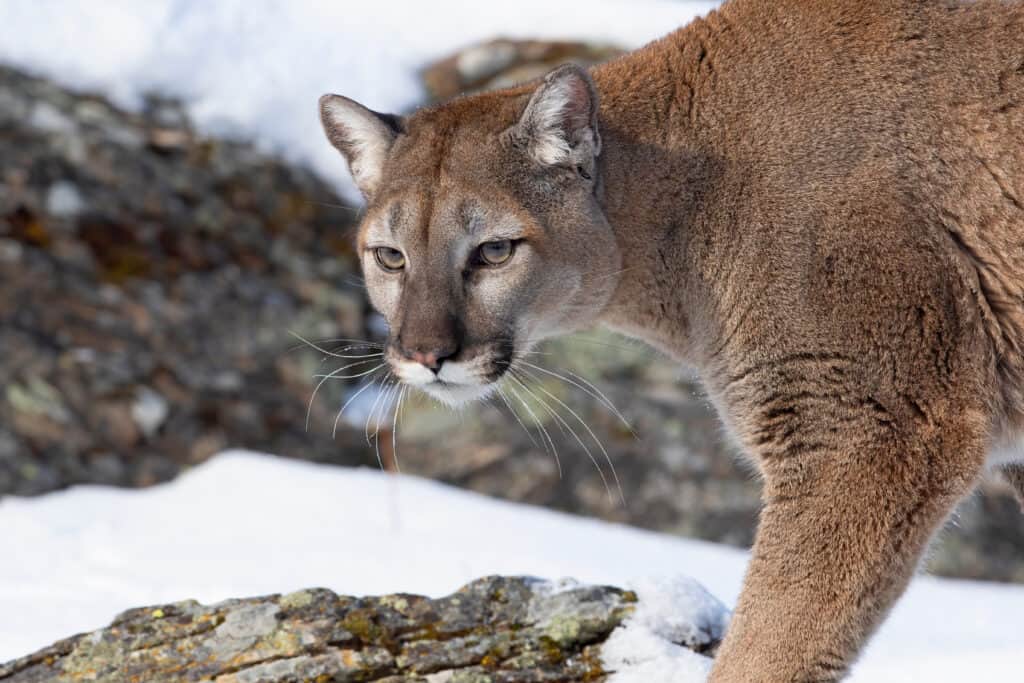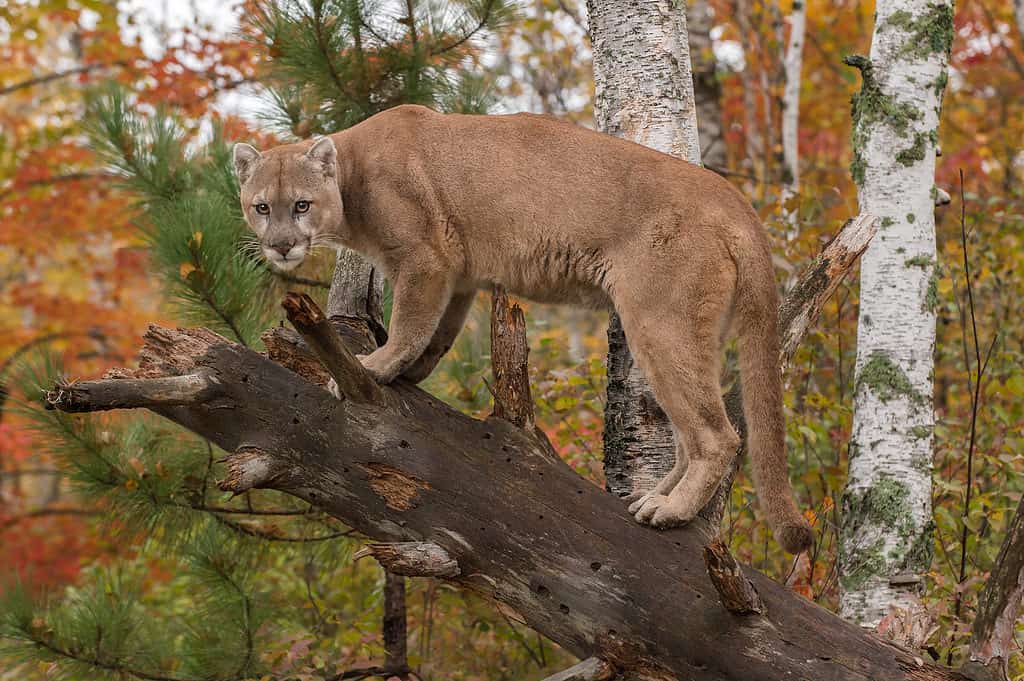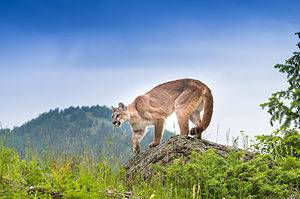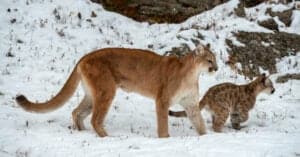When most people think of Los Angeles, they think of Hollywood, Beverly Hills, and sunny beaches. With a population of 3.8 million, Los Angeles ranks as the second-largest city in the United States and third-largest in North America. It boasts of a rich history and amazing ethnic and cultural diversity that make it one of the most exciting cities in the world. Every year, approximately 50 million people travel to the City of Angels to appreciate everything it has to offer.
Few people know how many different animals live in and around Los Angeles. One such animal, the mountain lion, captures the imagination like no other. These elusive big cats prowl the hills around Los Angeles, dodging cars and trail cameras as they hunt for food. Along with Mumbai, India, Los Angeles ranks as one of the few megacities in the world where big cats live in close proximity to humans. In this article, we’ll examine the mountain lion population in Los Angeles. We’ll also take a look at whether the population is increasing or decreasing and what threats mountain lions face.
Mountains Lions: Types and Appearance

Mountain lions possess round and erect ears.
©Jim Cumming/Shutterstock.com
The mountain lion belongs to the big cat family Felidae. In certain regions, it goes by the name puma, catamount, or panther. The mountain lion ranks as the second-largest big cat in the Americas after the jaguar. On average, adults stand 24 to 35 inches at the shoulder. From nose to tail, they range from 4 feet, 11 inches to 9 feet long, with males measuring longer than females. The tail alone typically measures from 25 to 37 inches long. Males usually weigh between 117 and 220 pounds, while females weigh between 64 and 141 pounds.
Mountain lions possess round and erect ears. The forepaws feature 5 retractable claws and the hind paws 4 retractable claws. Their long legs are proportionally larger than any other big cat in the family Felidae. These long legs allow them to leap 18 feet into the air and quickly sprint over short distances. Most mountain lions sport tawny-colored coats, but they can range from reddish to silvery-gray.
Where to Find Mountain Lions
You can find mountain lions throughout almost the entirety of North America. In fact, no other wild animal enjoys a larger distribution than the mountain lion. They range as far north as the Yukon Territory in Canada and as far south as the southern Andes in Chile. That said, mountain lions have been extirpated from much of their historical range. For example, they no longer live in eastern North America except for a small population in Florida. Within their current range, mountain lions live in a wide variety of environments. You can find them in forests, mountainous deserts, and shrublands. Many mountain lions live at high elevations, up to 19,000 feet, hence the name mountain lion.
Most mountain lions around Los Angeles live in the Santa Monica Mountains to the northwest of the city. Until recently, Los Angeles most famous lion, P-022, lived in Griffith Park just north of Hollywood. Farther north, you can find mountain lions in the Angeles National Forest and Rocky Peak Park near Santa Clarita. While mountain lions in Los Angeles typically stay at least 1 kilometer away from populated areas, they will occasionally cross highways and through residential areas to reach disconnected parts of their territories.
What’s the Mountain Lion Population Around Los Angeles?

The National Park Service tracks around two dozen mountain lions around Los Angeles.
©Geoffrey Kuchera/Shutterstock.com
Over the past 40 years, researchers worked diligently to track mountain lion populations in California. Using trackers and studies of mountain lion behavior, researchers derived estimates of the state’s total mountain lion population. That said, at the end of the day, these estimates are simply that, estimates. Researchers can’t say for sure exactly how many mountain lions live in the state. In the 1920s, experts believed that as few as 600 mountain lions lived in California. They revised that number to between 2,000 and 3,000 in the 1970s. Today, most researchers believe that between 4,000 and 6,000 mountain lions roam the state at any one time.
During the last 20 years, researchers went to great lengths to accurately catalog the mountain lion population around Los Angeles. During that span, employees of the National Parks Service (NPS) and the California Department of Fish and Wildlife (CDFW) identified around 100 mountain lions living in and around Los Angeles. In 2014, the CDFW embarked on a journey to collect even more accurate information both in the field and using rigorous data analysis methods.
Currently, National Park Service tracks around two dozen mountain lions around Los Angeles. To track each mountain lion, researchers must first capture and then sedate them. From there, they can then attach radio collars around the lions’ necks. With the collars attached, each lion then receives a call sign beginning with the letter “P” followed by a number. The first tagged lion – P001 – received the moniker the “king of the mountains,” and many of the lions in the region today can trace their lineage back to him.
Occasionally, the radio collars fall off or stop working, which interferes with the tracking of the mountain lions’ movements. When this happens, researchers must instead rely on footage from trail cams and DNA evidence to ascertain whether a particular mountain lion remains alive. Understandably, this makes it very difficult to provide an exact count of the mountain lion population around Los Angeles.
Are Moutain Lions Increasing or Decreasing Around Los Angeles?
Despite what you may hear, the mountain lion population around Los Angeles appears rather stable. Thanks to the efforts of NPS and CDFW staff, researchers can reliably estimate that the mountain lion population in Los Angeles has held steady at around two dozen or more for the past 40 years. Historically speaking, this represents a greater number than would likely naturally exist in the wild. In the wild, mountain lions typically command territories up to 200 square miles. Meanwhile, in Los Angeles, you can find 2 or 3 mountain lions who share the same 100 square miles of territory.
What Threats Do Mountain Lions Face?
Mountain lions in Los Angeles face unique threats compared to lions who live in more remote habitats. The number of threat that mountain lions face is habitat fracture. Mountain lions need to control vast territories to effectively hunt and breed. This need to roam puts mountain lions in direct confrontations with humans and one another. Due to habitat fracture, mountain lions in Los Angeles find it increasingly difficult to access disconnected parts of their territories. Roads, developments, and highways bisect their habitats, creating dangerous intersections that mountain lions must frequently cross. As a result, traffic collisions rank as one of the most common causes of death of mountain lions in Los Angeles.
Additionally, habitat fracture creates another issue, namely conflict between other lions. In the wild, mountain lions may fight with one another over territory, food, or breeding rights. However, when they have plenty of space, these fights should occur rarely. Within the tight confines around Los Angeles, mountain lions must compete over limited resources. Food and breeding opportunities are few and far between, which can lead to clashes between mountain lions. In fact, P-001, the former “king of the mountains,” killed his own mate, P-002, and several of his offspring, including P-005 and P-007.
Mountain lions must also deal with threats from other human-related activities. Although it is illegal to hunt mountain lions in California, some special permits are given to harvest mountain lions. Poaching also represents a threat, as witnessed in 2019 when a man shot and killed P-038 after the lion killed several animals on his property. Several other mountain lions in L.A. died from anticoagulant poisoning (rat poison), which only further highlights the numerous dangers they face.
Are Mountain Lions Dangerous?
It should go without saying that mountain lies are dangerous. They possess incredible power for their size and incredibly sharp claws and jaws. A small mountain lion can easily overpower even an exceptionally strong human, and you would stand no chance against one of the larger males. That said, mountain lions pose almost no danger to humans, statistically speaking. Human encounters with mountain lions happen very rarely, and when they do, the lions typically run away. In fact, in the last 100 years, only about 120 mountain lion attacks occurred in the United States. Of those 120 attacks, approximately 27 of them proved fatal. That means that mountain lions kill around 1 person every four years on average.
If you encounter a mountain lion in the wild, try to leave the area quickly and quietly. Announce your presence by talking loudly and calmly. Ideally, avoid walking alone, as this will make you a more likely target for a mountain lion. Do not approach mountain lion cubs, even if they appear alone. More than likely, the mother may be close by, which may entice her to try to defend her cubs. Mountain lions rest during the day, so you should avoid hiking at night in areas that they frequent. If you wish to take extra precautions, you can carry mace while you go hiking or ensure that you only walk in groups with other people.
Conclusion
The mountain lions of Los Angeles are celebrities in their own right. While they continue to face myriad threats, the mountain lion population appears stable. Further research is needed to monitor and maintain the mountain lion’s presence in Los Angeles. Hopefully, mountain lions continue to roam the Hollywood and Santa Monica Mountains for years to come.
The photo featured at the top of this post is © Warren Metcalf/Shutterstock.com
Sources
- , Available here: https://www.nps.gov/samo/learn/news/mountain-lions-in-los-angeles-moved-less-with-fewer-humans-in-parks-during-the-covid-19-stay-at-home-order.htm
- , Available here: https://www.ioes.ucla.edu/article/los-angeles-is-a-metropolitan-den-for-mountain-lions/
- , Available here: https://www.cbsnews.com/news/hollywood-cat-mountain-lion-p-22-euthanized-injuries-poor-health-los-angeles/
- , Available here: https://www.nps.gov/samo/learn/nature/puma-profiles.htm
Thank you for reading! Have some feedback for us? Contact the AZ Animals editorial team.






